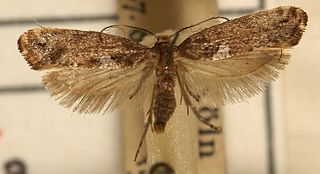
The Acrolepiidae are a family of moths known as false diamondback moths. In modern classifications, they are often treated as a subfamily (Acrolepiinae) of the family Glyphipterigidae.

Adelaide Island is a large, mainly ice-covered island, 139 kilometres (75 nmi) long and 37 kilometres (20 nmi) wide, lying at the north side of Marguerite Bay off the west coast of the Antarctic Peninsula. The Ginger Islands lie off the southern end. Mount Bodys is the easternmost mountain on Adelaide Island, rising to over 1,220 m. The island lies within the Argentine, British and Chilean Antarctic claims.
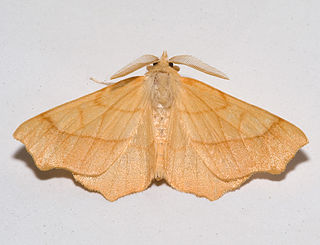
Ennomos quercinaria, the August thorn, is a moth of the family Geometridae. The species can be found in Europe. It was first described by Johann Siegfried Hufnagel in 1767.

Elachista atricomella is a moth of the family Elachistidae that is found in Europe.

Rhodostrophia calabra is a moth of the family Geometridae first described by Vincenzo Petagna in 1786. It is found from the Iberian Peninsula and a small isolated population in Morocco, through southern France, the western and southern Alps, Italy, the eastern coast of the Adriatic Sea to the southern parts of the Balkan Peninsula. In central Europe it is only found as an isolated population in central France and Rheinland-Pfalz. It is not found on the islands in the Mediterranean Sea. In the Balkans there is an isolated population in the border region of northern Bulgaria and Serbia. Furthermore, it is present on the eastern shores of the Black Sea in Turkey and in the Caucasus.

The lobster-clawed moth is a moth of the family Gelechiidae. It is found in most of Europe, except for the Iberian Peninsula and most of the Balkan Peninsula. In the east, the range extends to Siberia and Taiwan.

Lampronia corticella, the raspberry moth, is a moth of the family Prodoxidae. The species was first described by Carl Linnaeus in his 1758 10th edition of Systema Naturae. It is found in most of Europe, except Iceland, the Iberian Peninsula and the Balkan Peninsula. It is an introduced species in North America, where it was first detected in New Brunswick, Canada, in 1936.

Hellinsia didactylites is a moth of the family Pterophoridae. It is found in most of Europe, east into Russia.

Eudemis porphyrana is a moth of the family Tortricidae. It is found in most of Europe, east to the eastern part of the Palearctic realm.

Jordanita globulariae, also known as the scarce forester, is a day-flying moth of the family Zygaenidae.

Depressaria olerella is a moth of the family Depressariidae. It is found in most of Europe, except Ireland, the Netherlands, the Iberian Peninsula and most of the Balkan Peninsula.
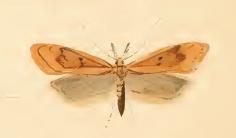
Dichomeris derasella is a moth of the family Gelechiidae. It is found in most of Europe, except Ireland, Norway, Sweden, the Iberian Peninsula and part of the Balkan Peninsula.

Quercus pyrenaica, commonly known as Pyrenean oak, is a tree native to southwestern Europe and northwestern North Africa. Despite its common name, it is rarely found in the Pyrenees Mountains and is more abundant in northern Portugal and north and northwestern Spain.
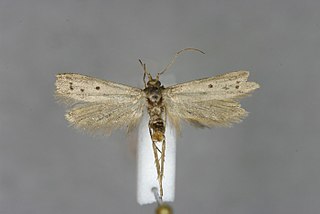
Hypatopa binotella, the spotted dowd moth, is a moth in the family Blastobasidae. It is found in most of mainland Europe, except the Iberian Peninsula and most of the Balkan Peninsula. It was first recorded from Great Britain in 2006 where it is probably accidentally imported.
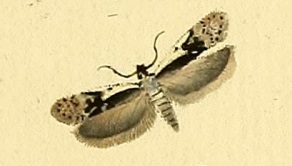
Anacampsis blattariella, the birch sober, is a moth of the family Gelechiidae. It is found in most of Europe, except Ireland, the Iberian Peninsula and most of the Balkan Peninsula.

Chionodes lugubrella is a moth of the family Gelechiidae. The geographical distribution of this species extends throughout Europe, into the Caucasus, Siberia and the Russian Far East. It is also found in North America.

Grapholita lobarzewskii, the appleseed moth, small fruit tortrix or smaller fruit tortrix moth, is a moth of the family Tortricidae. It was described by Maksymilian Nowicki in 1860. It is found in large parts of Europe, except Norway, Sweden, the Iberian Peninsula and most of the Balkan Peninsula.
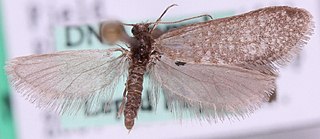
Siederia listerella is a moth of the Psychidae family. It was described by Carl Linnaeus in 1758. It is found in most of Europe, except Ireland, Great Britain, the Iberian Peninsula and most of the Balkan Peninsula.

Haplotinea insectella, the drab clothes moth or fungus grain moth, is a moth of the family Tineidae. It was described by Johan Christian Fabricius in 1794. It is found in all of Europe, except Ireland, the Iberian Peninsula and the western and southern part of the Balkan Peninsula. It is also found in North America. The species is often found in warehouses, granaries, mills and farm buildings.

Decantha borkhausenii is a moth of the family Oecophoridae. It is the type species of the genus Decantha, although it was once placed in the genus Oecophora. It is found in most of Europe, except Ireland, Great Britain, the Benelux, the Iberian Peninsula, most of the Balkan Peninsula, Denmark and Lithuania.

















